Banded Krait
Banded Krait (Bungarus fasciatus)
These are yellow and black kraits here in Thailand. In some other part of the world (Borneo) they are black and white. There are also “Blue Kraits“ aka “Malayan Kraits” which are black and white. And the really incredible looking Red-headed Krait which looks nothing like either of them.
[Last updated: 14 July 2023]
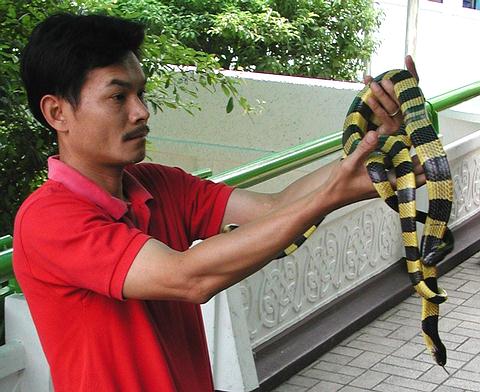
Bungarus Fasciatus (Banded Krait)
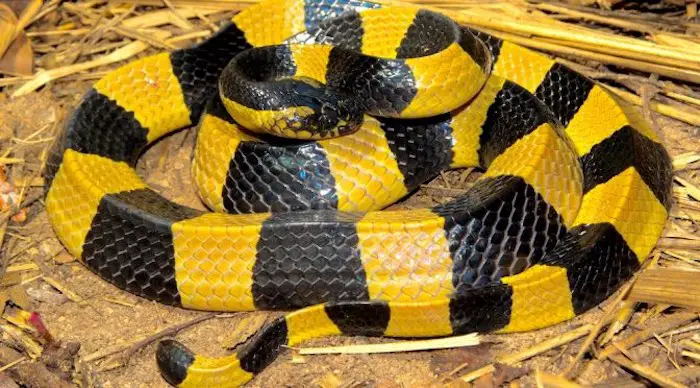
Thais say: (ngoo sam lee-um, or ngoo kan plong) This is a bit confusing in Thailand where in southern Thailand any viper is known as Ngoo sam lee-um. Lee-um means triangle, and so some people confuse the triangle-shaped heads of the vipers with the triangle cross-sections of the kraits.
Length: average 1.5 m up to 2 m (about 6.5 feet) In Thailand they don’t usually reach a full 2 meters, but I have seen one that was just over 2m.
Range: All over Thailand and most of Asia. Never found in Krabi province, oddly enough.
Notes: Banded kraits are secretive, meaning they are mobile at night and prefer grass or other greenery to hide them. I have seen a few dead on the roads – but I don’t go digging up ratholes or termite mounds. I may start if I don’t find one soon.
I’ve been looking for three years to find a krait with yellow and black bands like these.
At dinner last night I was looking around a small restaurant with many ponds, for snakes. I asked the owner’s son if they had seen any. He said, Ngoo Sam lee-um. That could be the one. I’ll get their permission for some late-night herping and try to bag one.
I’m sure they’ll appreciate it. This restaurant is located on a small hill close to sea level in southern Thailand. There are many frogs at the ponds, and probably many snakes too.
Update 2021- I’ve been to that restaurant numerous times and have not had a call from them about this krait. I am not sure they have been found in Krabi. I have never found roadkill B. fasciatus here in Krabi.
I have found a large 2-meter banded krait dead on the road banded krait in Surat Thani on the main highway leading to Krabi.

Habitat: This Thailand krait lives on the ground and in rat holes and termite mounds, under stumps or rocks and in other cool, damp places. Recently I saw photos of one in some limestone rocks here in Thailand. They prefer wide-open areas near water.
Rice fields and mangrove areas are the best places to start looking for them at night.
They have been found as high as 1,524 meters in Malaysia and about 2,300 meters in Thailand.
Active Time? The snake is mostly nocturnal and is quite active at night. Most bites occur at night, as the kraits move close to people sleeping – usually on the floor, and probably the person moves and the krait bites. More dangerous at night, during the day they are not biters. These kraits are common in the northeast Thailand provinces.
Recently a six-year-old boy was bitten and could not be revived. The snake had come up into their home in Surin to escape some flooding.
Food: Other snakes almost exclusively – rat and cat (Boiga) snakes. In captivity, I have seen them eat the following live snakes: Calloselasma rhodostoma, Chrysopelea ornata, and Gonyosoma oxycephalum. One noted herpetologist states that these kraits don’t like to eat water snakes.
Will also eat rats, mice, frogs, lizards if snakes cannot be found.
Defensive Behavior: The banded krait is slow acting during the day, lethargic, and usually not interested in striking. However, it can protect itself quite well – it is a strong biter and has been recorded as killing a large type of cattle 60 minutes after a bite.
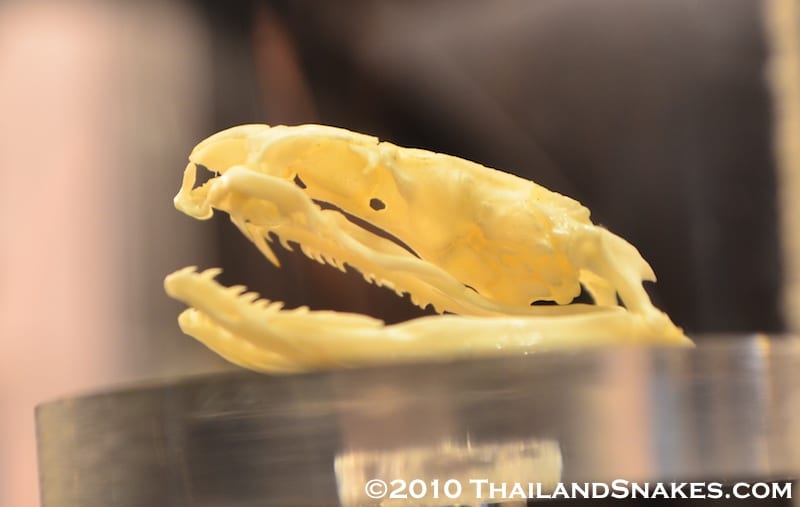
Banded Krait skull showing fangs, jaw, and other dentition. Skull located at Queen Saovabha Memorial Institute in Bangkok, Thailand. ©Vern Lovic.
Venom Toxicity: Very toxic. Deadly. This yellow/black banded krait from Thailand appears to have venom that is very toxic to humans. The typical LD-50 studies to assess the toxicity of venom in mice, rate this as a very toxic venom as well.
These snakes rarely bite during the day, but if they do, they can transfer enough venom to kill you. I read about a person dying in 30 minutes, and another dying in 15 hours.
A famous American herpetologist, Joe Slowinski, was killed by a baby krait (Bungarus multicinctus) in Burma while on a remote expedition. He finally succumbed after 30 hours. They can be quite deadly.
The cause of death is that your muscles are paralyzed and your diaphragm can’t work any longer to pull oxygen into your lungs.
Kraits are very deadly in this regard. However, if you are able to get to a hospital with a ventilator you will likely be OK. There is no specific antivenin for snake bites from this snake, but polyvalent venom is used – which can also treat bites from Naja kaouthia and Ophiophagus hannah.
Interesting to note… when fed on a live garter snake the krait venom acts instantly to cause death. Apparently, krait venom is very efficient with snakes – the krait’s primary diet.
Handling: The banded and Malayan blue kraits are not known to bite during the daytime. However, at night time they bite rather easily, as evidenced by the numerous krait bites that occur at night to people usually laying down to sleep on the floor either outdoors or in their homes with the door open.
I would never handhold kraits like the man is doing in the photo above. The krait venom is so toxic, it’s just not worth the risk – however small. Their venom is stronger than that of monocled cobras.
Antivenin: Polyvalent. It is advised by experts to get antivenin in your bloodstream for krait bites before you have symptoms because once symptoms develop you may have lost nerve functioning that will likely not return.
Offspring: Mating in March-April and 4-14 eggs laid about 60 days afterward. The mother krait remains with the eggs for another 60 days before they hatch. Baby kraits are about 30cm long at birth and have venom.
I couldn’t find in the literature whether the mother left the eggs as they started hatching – so she didn’t eat them herself or not. The King Cobra does this instinctively because it also eats other snakes.
Update: I was contacted by a man who was bitten by this same type of krait during the night (midnight) at an impromptu show at a bar in Bangkok. The snake handler let him hold it and it bit his arm deeply. He was lucky to live and had lingering effects for more than five years after the bite!
Banded Krait Scientific Classification
Kingdom: Animalia
Phylum: Chordata
Subphylum: Vertebrata
Class: Reptilia
Order: Squamata
Suborder: Serpentes
Family: Elapidae
Genus: Bungarus
Species: B. fasciatus
Binomial name
Bungarus fasciatus
Classified by Schneider in year 1801
Photo of Two Adult Banded Kraits:
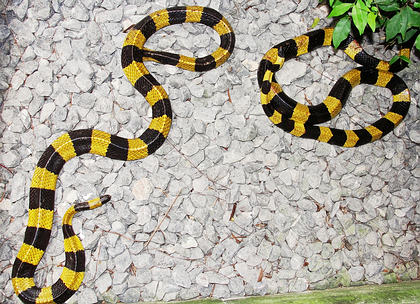
Video of Jackie with Banded Krait from Nakhon Si Thammarat, Southern Thailand:

Venomous Snakebites and Near Misses!
More than 34 stories of venomous snakebites and very near misses from Southeast Asia’s most deadly snakes – King Cobra, Malayan Pit Viper, Monocled Cobra, Banded Krait, Malayan Krait, and more! Digital Book with over 100 pages by Vern Lovic.

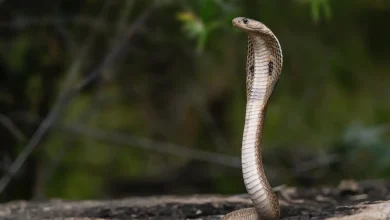
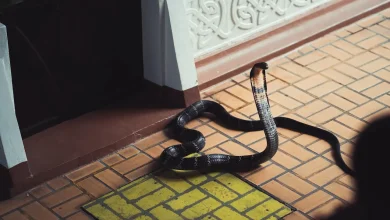
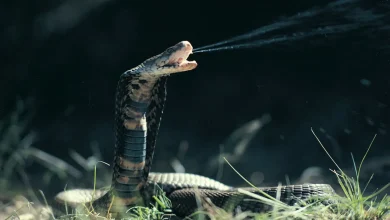
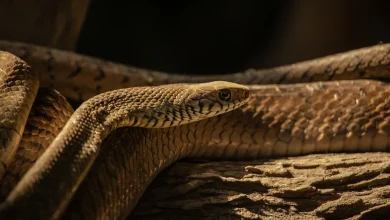
Just saw a juvenile sized one this A.M. while picking up litter (With a rake.) Let it go tho,I figured it was dangerous. We’re near Sanpatong,if anyone wants to come catch it,E-mail me. I’d rather not kill or even bother it but I don’t know if I can seal this old,wood house well enough to keep it out during the rains.
I actually found a yellow banded krait several years ago at my house in San Diego. It was right outside my door as I opened it. I took pictures and called the police. They had several people there in a matter of 30 minutes to catch it. They told me that they are only native to Asia and that one of my neighbors probably had it as a pet, and either let it go or it got loose. Very Scary! It was well over 4ft long.
That’s weird. I’ve had people in Thailand send me photos of snakes that were found here and yet were not native at all to this area. It happens, I guess…
Moving to krabi and koh lanta in a few weeks never been to that part of Thailand before. Heard the malayan krait is there at home in this area. Do they really come into beds? staying in a hotel and not laying on the floor by the way… Should I cool down the room as much as i could that none of them want to hang out in there?
Hi Dennis,
Snakes are not that commonly found that you’d have to give it that much thought. I did read your other message and you asked about a headlamp for night walking – yes, absolutely do that. Malayan pit vipers are active at night. No, you’ll never find a Malayan pit viper in your bed. They’re not climbers. Keep your doors shut and they’ll stay out. They are not found inside homes much anyway. Occasionally they’ll come up through a drain pipe, so keep drains capped – shower especially.
Cooling the room may help I guess. They don’t like low humidity, so air conditioned rooms may help some. I wouldn’t rely on that. Just keeping screens in windows and doors shut will help tremendously.
Cheers, and best of luck!
I was with brother monitoring in our pond this night and we saw 2 of that branded krait about 1.5m in lengths ,seems dangerous but we never thought that much since as far as we know cobras are only snakes that should not mess with, until I search in Internet. Now I feel much worried knowing the danger it brings. But somehow I appreciate this info kinda aware now.
About 3 years ago I was drinking beers with a friend in Northern Thailand one evening. I needed to pee, so I set off for the bushes a few meters away, but as i approached the edge of the patio where it meets the grass, something made me stop right there. I didn’t think much about it, but figured I’d just pee on the grass, as it was only us 2 guys on his whole property anyway. As I looked down at the grass to pee, there I saw it- a yellow & black banded krait was directly where my first footstep off the patio would have occurred. I do not consider this to be luck, but rather, divine protection. Whenever you sense a simple knowing within, hush your mind and just heed it. A higher wisdom guides us, but it usually whispers and doesn’t waste time explaining itself. “Stop” was the highest wisdom needed at that moment. Thank God I listened.
Amazing. I’ve never pain ANY attention to intuition in my early years. As I get older, yeah, it’s something that you don’t want to miss!
Found 2 meter lovely specimen in my shed today.. Didn’t have the heart to kill it as too beautiful.. Let the local snake catcher take it away.. Wish I could send a photo.. Hat Yai… Songkhla